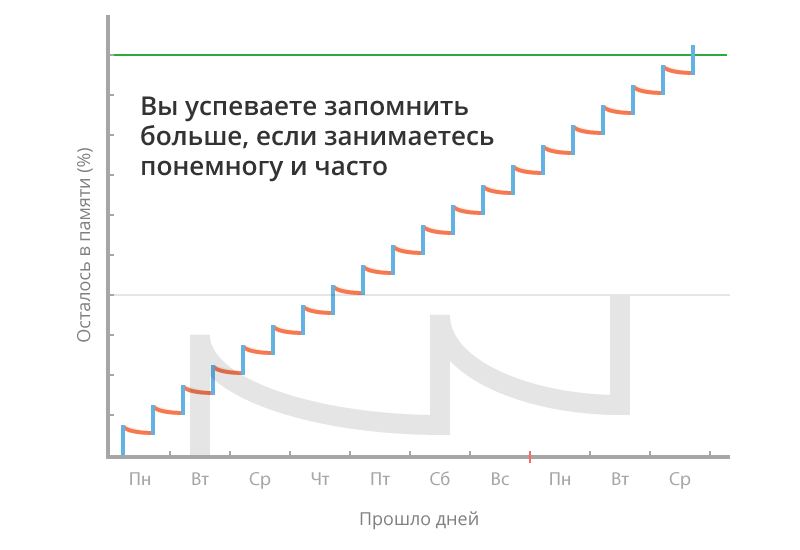Memorize effectively: two important principles in language learning

In June, Arthur Dumchev, the record holder of the Russian Book of Memories, a recognized memory development expert, trainer and consultant, joined the LinguaLeo team. Arthur remembers the number "Pi" up to 22,528 decimal places and is the author of the book Remember All. A practical guide to the development of memory .
At the moment, Arthur is working in LinguaLeo on the introduction of additional effective methods of memorizing words and phrases. We asked him to share tips on fast and high-quality language learning with readers of our blog, and Arthur told us about such hacks as “reasonable use of mnemotechnics” and “systematics in teaching”. So, what is it, and will it help in memory development and language learning? Let's see.
')
Reasonable use of mnemotechnics
A mnemonic technique is a collection of techniques that facilitate memorization. An example of using mnemotechnics: we need to memorize the word Shrug - “shrug”. To do this, it is enough to present some visual image that will allow you to remember the word and its translation. For example, Shrek shrugs. When you hear Shrug, you will immediately recall this image, and then the translation of the word.
On Habré there are several good articles about mnemotechnics, where the basic principles are described in detail. Here they are: about mnemonics , one and two times about mnemonics and language. Arthur used similar methods to memorize Pi. “After becoming acquainted with mnemonic, I tried to apply it wherever possible. I tried to memorize new routes, events from the life, conversations and phrases, names and faces, lectures at the university and books. Of course, I also used mnemonics to learn foreign languages — I learned how to memorize up to 100 words per hour. But this does not mean at all that you can spend 40 hours and in 5-6 days to memorize 4,000 words of quality ”.
In memory championships, mnemonic athletes memorize 300 or more foreign words per hour. Why don't they become polyglot? The fact is that the next day after the competition such an athlete mnemonist probably will not remember even 50 words out of 300 memorized. And those 50, which he still remembered, he can not instantly recognize in speech.
If you want to translate a word into an active lexical reserve, you need to find it several dozen times in the text, hear it a few dozen times in speech and, most importantly, start using it yourself. This also applies to the words that you memorized with the help of mnemonics: as long as you do not use them in speech, they will, at best, be in passive reserves. When you start using them, they will be remembered directly, without images.
This raises the question of the feasibility of using mnemo. Why waste time inventing any images, if in the end the required number of repetitions still ensures memorization? It is necessary to take into account 2 points:
FOR: Mnotehnika makes it possible to memorize faster. You pick up an image once - and from that moment on the word goes into your passive vocabulary. Quickly remember the word without images or associations will not work.
AGAINST: Sometimes the selection of images takes too much time, and the images themselves do not make it easy to remember the word. Imagine you want to remember that conclusive translates as convincing. What images would you pick? Would imagine how a horse speaks with cranberries very convincingly?
Conclusion : mnemonics should be used when it is convenient. Consider two cases:
• If associations are automatically put on the word, then, of course, the use of mnemonics will speed up memorization.
Examples:
pillar - pillar. Imagine how you are sawing some post.
broth - broth. Try to see how the brooch fell into the broth.
ledge - ledge, ledge. Imagine that you wanted to lie down and lay down on the ledge.
• Words for which simple associations are not selected are best remembered by repeating.
Examples:
contemplate - contemplate, meditate,
contemporary - contemporary;
contempt - contempt;
condemn - to condemn.
There are a lot of words beginning with “con”. If you use the image of a horse or canned food every time, you will soon get confused. A possible option is to mentally select a special building in which you will place images of only those words that begin with “con”, but this technique would be more suitable for high-speed memorization at competitions. Learning a language is an extra and unnecessary step that just takes extra time.
Systematics in training
Arthur took about two months to memorize 22,528 characters of pi. Then for about six months he kept him in his memory, repeating a thousand digits daily - it took 10-20 minutes, depending on the concentration of attention. Immediately before the record, Arthur actively (5-10 hours a day) repeated the number for another month.
Let's draw an analogy. Arthur used one image to memorize two numbers. To memorize one foreign word with translation, he would need two images - for the word itself and for its translation. If two numbers are one image, and two words are four images, then you can roughly equate 22,528 numbers to the vocabulary of 5,632 words (22,528 / 4). That is, it is conditionally possible to assume that if Arthur, instead of memorizing the number Pi, had studied a new foreign language, he would have moved more than 5 thousand words into his vocabulary. According to him, the systematics plays an important role: whatever happens, you need to devote at least 10 minutes of repetition every day. Successful experience in learning languages, as a rule, is also associated with the need to study daily.
A couple of polyglot stories
The famous archaeologist and entrepreneur Heinrich Schliemann was fluent in more than 10 languages. It took him 6 weeks to learn a new language, after which he could speak freely with the speakers. Maybe it's in his natural abilities? It is quite possible, but it is impossible not to mention that when Schliemann took up another language, he devoted almost all his free time to him. There is a good article in which facts and conclusions from Schliemann’s experience in learning languages are briefly described.
Another famous polyglot, Kato Lomb, one of the first simultaneous interpreters in the world, studied languages through reading fiction. At the same time, she tried to understand the grammatical rules on her own, already referring to the textbooks. The method is harsh: no video with subtitles, no interactive courses. Just a book in the original and a dictionary. How did she manage to learn more than 10 languages using this technique? The answer can be found in two quotes from her book, How I Learn Languages:
"If someone is not able to donate for this and an hour and a half a day, then the proposed method (however, in no other way) will not achieve the desired result."
"Bitter experience, but it is necessary to declare it: the time spent on the study will be in vain if you do not achieve a certain density of classes a week, and even better - a day."
How to explain the need for daily activities?
Sisyphean toil
At the end of the XIX century, the German psychologist Herman Ebbingauz, conducting experiments with memorizing meaningless syllables, revealed an interesting pattern: at first, forgetting goes very quickly and then slows down.

Suppose you decide to study English on Tuesdays and Saturdays - 4 hours one lesson (only 8 hours a week). Here's how this could be presented on a forgetting schedule.

And this would look like 2 classes per day, 30 minutes each (only 7 hours per week)

The advantage of daily activities is that you repeat each specific word or language pattern more likely before you forget it. At the same time, many, knowing that it is necessary to practice every day, continue to deceive themselves: “Today I’m busy, I will work tomorrow or the day after tomorrow ...” What is the result? You memorize words and rules, then forget them and you have to memorize them again, so it takes not 3-4 months to learn a language, but several years. It is better to immediately take up the tongue seriously. To do this, follow only two rules:
1. Allocate 30 minutes a day, which you completely devote to learning a language.
2. Do additional work during the day - for this you can use the time that usually disappears in traffic jams, in lines, in the subway.
Engage every day with LinguaLeo, have fun and result! Follow our news on Twitter , Facebook , vkontakte and Instagram .
Source: https://habr.com/ru/post/230903/
All Articles